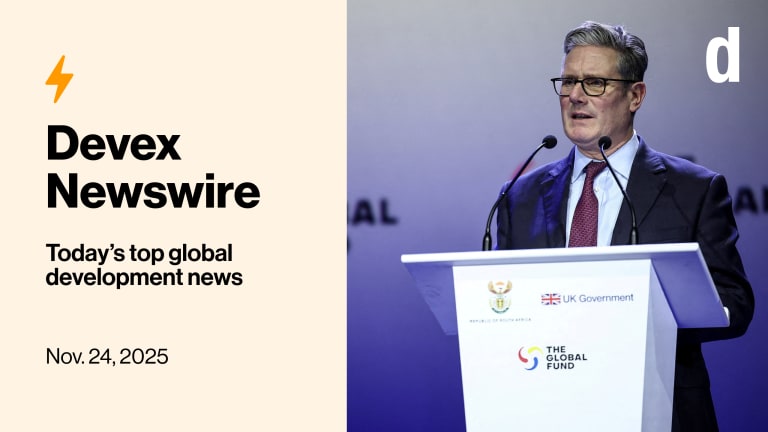New report reveals limited funding for global south organizations
Despite pledges to localize funding and untie foreign aid, over 90% of the global north's official development assistance still flows to organizations in their own countries.
Less than one-tenth of the official development assistance funneled to civil society goes toward organizations in the global south, according to a new report released last week — one that analyzed the funding behaviors of a dozen donors from 2009 to 2021. The report, Too Southern to be Funded, was published by the #ShiftThePower movement, a coalition of organizations pushing for locally led development. It found that almost 63% of funding went to countries’ own civil society organizations, while just under 29% went to civil society in other global north countries, leaving a little over 8% for organizations in the global south. “For some reason, various governments think their own INGOs are best placed to deal with the challenges around the world, rather than the organizations in those communities,” said Dylan Mathews, the chief executive officer of Peace Direct, an organization that backed the report. “Why do we still believe that?” Too Southern to be Funded looks specifically at countries within the Organisation for Economic Co-operation and Development’s Development Assistance Committee, a set of 32 countries based primarily in North America and Europe. By analyzing OECD data, the report looked at official development assistance from 12 donor countries between 2009 and 2021 — the United States, Germany, the United Kingdom, Sweden, the Netherlands, Canada, Norway, Switzerland, Belgium, Finland, Ireland, and Iceland. It found that in 2021, just $2 billion was channeled to civil society organizations in the global south, a fraction of the $24 billion funneled toward such organizations overall. The report’s findings bring up a question that organizations have been struggling to answer for years: Does an international agency’s country office — one that might be staffed with local employees — actually count as local? For Peace Direct’s Mathews, the answer to that question is a resounding no. “The power of the brand gives organizations privileged access, funding, contacts,” Mathews continued. “They aren’t masters of their own destiny if they’re not the ones setting the agenda.” Of all the countries analyzed, the United States is reported as performing the worst, contributing just an average of 0.5% of bilateral official development assistance toward global south CSOs during the decade analyzed. However, during the 2021 fiscal year that figure jumped to 7.3% — a change that largely seems due to a shift in reporting, suggesting that the U.S. may have been doing better than appears in previous years. Germany, Belgium, and Finland had the next lowest average proportions from 2009 to 2021, at 0.6%, 1.8%, and 3.2% respectively. Switzerland, at 16.5%, had the highest. In many countries, cash restrictions came from the top. The report found development policies that required donor agencies to fund their own civil society organizations. In Belgium, for example, only accredited nongovernmental organizations can apply for direct funding from the country — and to do so, they must comply with a strict set of criteria. One of those benchmarks, the report found, was to have a “demonstrable ‘assise societale’ (societal base) in Belgium.” “One of the elephants in the room is this conversation on trust, and whether the global north trusts global south civil society to do the work it wants to do.” --— Eshban Kwesiga, manager, Global Fund for Community Foundations Though organizations in the global south can receive funding through a partnership with a global north-based NGO, certain line items, such as emergency and food aid, are supplied exclusively to Belgian organizations, international groups, and the International Federation of Red Cross, according to the report. The report refers to the fact that 20 years ago, the world’s largest bilateral donors pledged to untie foreign aid — essentially, to remove restrictions mandating aid be used to buy goods and services from a donor’s own country. But for those behind the report, funneling cash toward civil society organizations headquartered in the global north is another way of doing just that. “One of the elephants in the room is this conversation on trust, and whether the global north trusts global south civil society to do the work it wants to do,” said Eshban Kwesiga, a manager at the Global Fund for Community Foundations, one of the organizations in the #ShiftThePower movement. The bulk of the countries surveyed —Canada, Finland, Germany, Iceland, Ireland, the Netherlands, Sweden, Switzerland, and the United Kingdom — were found to partially restrict or tie funding to civil society organizations based in their own countries. Belgium had legislation that restricted funding to domestic organizations altogether, the report stated. The United States and Norway were the only two countries without formal restrictions, though the report found the countries did have “informal tying” — the United States, for example, was said to have no formal restrictions, yet a historical pattern of funding mostly domestic or other global north-based NGOs. “Although this is a complex and contentious issue, the overarching message and key takeaway from this research is clear: to increase the quantity of direct, high-quality (especially core) funding to CSOs in the Global South, most DAC donors will have to change either legislative or policy frameworks and/or introduce new funding channels or mechanisms,” the report stated.
Less than one-tenth of the official development assistance funneled to civil society goes toward organizations in the global south, according to a new report released last week — one that analyzed the funding behaviors of a dozen donors from 2009 to 2021.
The report, Too Southern to be Funded, was published by the #ShiftThePower movement, a coalition of organizations pushing for locally led development. It found that almost 63% of funding went to countries’ own civil society organizations, while just under 29% went to civil society in other global north countries, leaving a little over 8% for organizations in the global south.
“For some reason, various governments think their own INGOs are best placed to deal with the challenges around the world, rather than the organizations in those communities,” said Dylan Mathews, the chief executive officer of Peace Direct, an organization that backed the report. “Why do we still believe that?”
This story is forDevex Promembers
Unlock this story now with a 15-day free trial of Devex Pro.
With a Devex Pro subscription you'll get access to deeper analysis and exclusive insights from our reporters and analysts.
Start my free trialRequest a group subscription Printing articles to share with others is a breach of our terms and conditions and copyright policy. Please use the sharing options on the left side of the article. Devex Pro members may share up to 10 articles per month using the Pro share tool ( ).
Elissa Miolene reports on USAID and the U.S. government at Devex. She previously covered education at The San Jose Mercury News, and has written for outlets like The Wall Street Journal, San Francisco Chronicle, Washingtonian magazine, among others. Before shifting to journalism, Elissa led communications for humanitarian agencies in the United States, East Africa, and South Asia.








